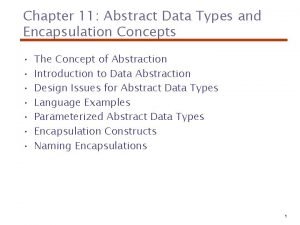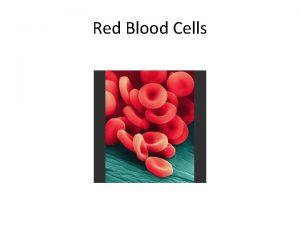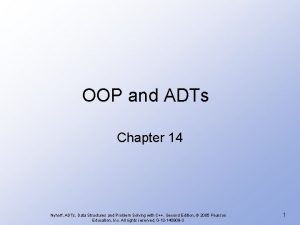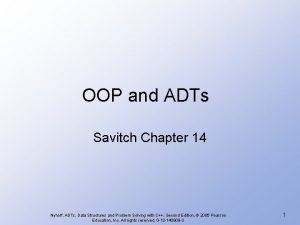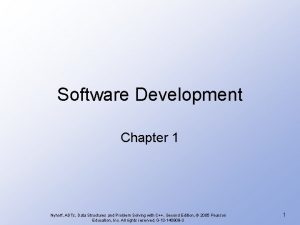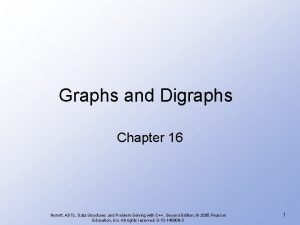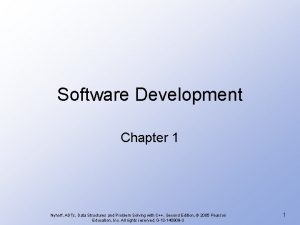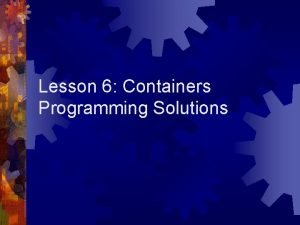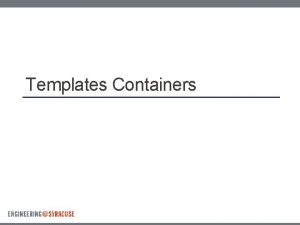Standard Containers Vectors Adapted from Nyhoff ADTs Data
















![Iterator Functions • Operators: ++, --, *, =. ==, !=, +, -, [ ] Iterator Functions • Operators: ++, --, *, =. ==, !=, +, -, [ ]](https://slidetodoc.com/presentation_image_h/df99cbbb364ffec6b25ea830836394e0/image-17.jpg)

- Slides: 18

Standard Containers: Vectors Adapted from Nyhoff, ADTs, Data Structures and Problem Solving with C++ 1

STL (Standard Template Library) A library of class and function templates Components: 1. Containers: Generic "off-the-shelf" class templates for storing collections of data 2. Algorithms: Generic "off-the-shelf" function templates for operating on containers 3. Iterators: Generalized "smart" pointers provide a generic way to access container elements 2

Standard Template Library • Example of a specific – container class – iterator – algorithm 3

STL's 10 Containers Kind of Container Sequential: STL Containers deque, list, vector Associative: map, multiset, set Adapters: priority_queue, stack 4

The vector Container • A type-independent pattern for an array class – capacity can expand – self contained • Declaration template <typename T> class vector {. . . } ; 5

The vector Container • Constructors vector<T> v, // empty vector v 1(100), // 100 elements of type T v 2(100, val), // 100 copies of val v 3(fptr, lptr); // contains copies of // elements in memory // locations fptr to lptr int. Array[5] = {9, 2, 7, 3, 12}; Int arr. Size = sizeof(int. Array)/sizeof(int); vector<int> int. Vector(int. Array, int. Array+arr. Size); 6

vector Operations • Information about a vector's contents – – v. size() v. empty() v. capacity() v. reserve(n) • Adding, removing, accessing elements – – v. push_back(value) v. pop_back() v. front() v. back() 7

vector Operations • Assignment v 1 = v 2 • Swapping v 1. swap(v 2) • Relational operators == implies element by element equality less than < behaves like string comparison 8

Increasing Capacity of a Vector • When vector v becomes full – capacity increased automatically when item added • Algorithm to increase capacity of vector<T> – Allocate new array to store vector's elements (how big) – use T copy constructor to copy existing elements to new array (therefore your class must have copy constructor) – Store item being added in new array – Destroy old array in vector<T> – Make new array the vector<T>'s storage array Expansion by addition is possible but costly 9

Increasing Capacity of a Vector • Allocate new array – Capacity doubles when more space needed • Elements copied to new array 10

Increasing Capacity of a Vector • Item being added now stored • Destroy old array • Make new array the vector's storage area 11

Iterators • A subscript operator is provided – BUT … this is not a generic way to access container elements • STL provides objects called iterators – can point at an element – can access the value within that element – can move from one element to another • They are independent of any particular container … thus a generic mechanism 12

Iterators • Given a vector which has had values placed in the first 4 locations: vector<int> v 9 v. begin() 4 15 3 v. end() • v. begin() will return the iterator value for the first slot, • v. end() for the next empty slot 13

Iterators • Each STL container declares an iterator type – can be used to define iterator objects • To declare an iterator object – the identifier iterator must be preceded by • name of container • scope operator : : • Example: vector<int>: : iterator vec. Iter = v. begin() 14

Iterators • Basic operators that can be applied to iterators: – increment operator ++ – decrement operator -– dereferencing operator * – Assignment = – Addition, subtraction +, -, +=, -= vec. Iter + n returns iterator positioned n elements away – Subscript operator [ ] vec. Iter[n] returns reference to nth element from current position 15

Iterators Contrast use of subscript vs. use of iterator ostream & operator<<(ostream & out, const vector<double> & v) { for (int i = 0; i < v. size(); i++) out << v[i] << " "; return out; } for (vector<double>: : iterator it = v. begin(); it != v. end(); it++) out << *it << " "; 16
![Iterator Functions Operators Iterator Functions • Operators: ++, --, *, =. ==, !=, +, -, [ ]](https://slidetodoc.com/presentation_image_h/df99cbbb364ffec6b25ea830836394e0/image-17.jpg)
Iterator Functions • Operators: ++, --, *, =. ==, !=, +, -, [ ] • Vector Functions: v. begin(), v. end(), v. rbegin(), v. rend(), v. insert(iter, value), v. insert(iter, n, value), v. erase(iter 1, iter 2) • Note the capability of the last two groupings – Possible to insert, erase elements of a vector anywhere in the vector – Must use iterators to do this – Note also these operations are as inefficient as for arrays due to the shifting required v. insert(iter, n, value) v. erase(iter 1, iter 2) 17

Contrast Vectors and Arrays Vectors • Capacity can increase Arrays • Fixed size, cannot be changed during execution (unless using dynamic alloc) • A self contained object • Is a class template • Has function members to do tasks • Cannot "operate" on itself • Must "re-invent the wheel" for most actions 18
 Adts, data structures, and problem solving with c++
Adts, data structures, and problem solving with c++ Parameterized adts is also known as
Parameterized adts is also known as Parameterized abstract data types
Parameterized abstract data types Adts ukiah
Adts ukiah This passage is adapted from jane austen
This passage is adapted from jane austen How are red blood cells adapted
How are red blood cells adapted Adapted with permission from
Adapted with permission from In what ways have the highland maya adapted to modern life?
In what ways have the highland maya adapted to modern life? Xerophytic plants diagram
Xerophytic plants diagram Chaparral biome location
Chaparral biome location Mensaje subliminal camel
Mensaje subliminal camel Sausage shaped organelles
Sausage shaped organelles The two brothers adapted
The two brothers adapted Adapted from the internet
Adapted from the internet How is amoeba adapted for gas exchange bbc bitesize
How is amoeba adapted for gas exchange bbc bitesize How have plants adapted to the rainforest
How have plants adapted to the rainforest Spermopsida
Spermopsida The outsiders adapted for struggling readers
The outsiders adapted for struggling readers Tied synoynm
Tied synoynm

